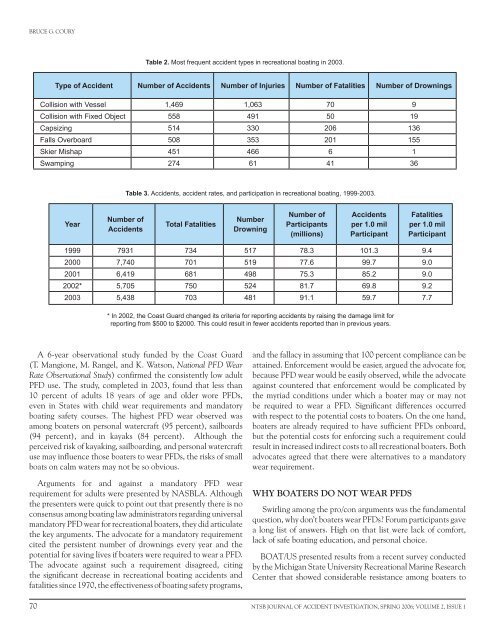Journal of Accident Investigation
Journal of Accident Investigation
Journal of Accident Investigation
Create successful ePaper yourself
Turn your PDF publications into a flip-book with our unique Google optimized e-Paper software.
BRUCE G. COURY<br />
A 6-year observational study funded by the Coast Guard<br />
(T. Mangione, M. Rangel, and K. Watson, National PFD Wear<br />
Rate Observational Study) confirmed the consistently low adult<br />
PFD use. The study, completed in 2003, found that less than<br />
10 percent <strong>of</strong> adults 18 years <strong>of</strong> age and older wore PFDs,<br />
even in States with child wear requirements and mandatory<br />
boating safety courses. The highest PFD wear observed was<br />
among boaters on personal watercraft (9 percent), sailboards<br />
(94 percent), and in kayaks (84 percent). Although the<br />
perceived risk <strong>of</strong> kayaking, sailboarding, and personal watercraft<br />
use may influence those boaters to wear PFDs, the risks <strong>of</strong> small<br />
boats on calm waters may not be so obvious.<br />
Arguments for and against a mandatory PFD wear<br />
requirement for adults were presented by NASBLA. Although<br />
the presenters were quick to point out that presently there is no<br />
consensus among boating law administrators regarding universal<br />
mandatory PFD wear for recreational boaters, they did articulate<br />
the key arguments. The advocate for a mandatory requirement<br />
cited the persistent number <strong>of</strong> drownings every year and the<br />
potential for saving lives if boaters were required to wear a PFD.<br />
The advocate against such a requirement disagreed, citing<br />
the significant decrease in recreational boating accidents and<br />
fatalities since 1970, the effectiveness <strong>of</strong> boating safety programs,<br />
Table 2. Most frequent accident types in recreational boating in 2003.<br />
Type <strong>of</strong> <strong>Accident</strong> Number <strong>of</strong> <strong>Accident</strong>s Number <strong>of</strong> Injuries Number <strong>of</strong> Fatalities Number <strong>of</strong> Drownings<br />
Collision with Vessel 1,469 1,063 70 9<br />
Collision with Fixed Object 558 491 50 19<br />
Capsizing 514 330 206 136<br />
Falls Overboard 508 353 201 155<br />
Skier Mishap 451 466 6 1<br />
Swamping 274 61 41 36<br />
Year<br />
Number <strong>of</strong><br />
<strong>Accident</strong>s<br />
Table 3. <strong>Accident</strong>s, accident rates, and participation in recreational boating, 1999-2003.<br />
Total Fatalities<br />
Number<br />
Drowning<br />
Number <strong>of</strong><br />
Participants<br />
(millions)<br />
<strong>Accident</strong>s<br />
per 1.0 mil<br />
Participant<br />
and the fallacy in assuming that 100 percent compliance can be<br />
attained. Enforcement would be easier, argued the advocate for,<br />
because PFD wear would be easily observed, while the advocate<br />
against countered that enforcement would be complicated by<br />
the myriad conditions under which a boater may or may not<br />
be required to wear a PFD. Significant differences occurred<br />
with respect to the potential costs to boaters. On the one hand,<br />
boaters are already required to have sufficient PFDs onboard,<br />
but the potential costs for enforcing such a requirement could<br />
result in increased indirect costs to all recreational boaters. Both<br />
advocates agreed that there were alternatives to a mandatory<br />
wear requirement.<br />
WHY BOATERS DO NOT WEAR PFDS<br />
Fatalities<br />
per 1.0 mil<br />
Participant<br />
1999 7931 734 517 78.3 101.3 9.4<br />
2000 7,740 701 519 77.6 99.7 9.0<br />
2001 6,419 681 498 75.3 85.2 9.0<br />
2002* 5,705 750 524 81.7 69.8 9.2<br />
2003 5,438 703 481 91.1 59.7 7.7<br />
* In 2002, the Coast Guard changed its criteria for reporting accidents by raising the damage limit for<br />
reporting from $500 to $2000. This could result in fewer accidents reported than in previous years.<br />
Swirling among the pro/con arguments was the fundamental<br />
question, why don’t boaters wear PFDs? Forum participants gave<br />
a long list <strong>of</strong> answers. High on that list were lack <strong>of</strong> comfort,<br />
lack <strong>of</strong> safe boating education, and personal choice.<br />
BOAT/US presented results from a recent survey conducted<br />
by the Michigan State University Recreational Marine Research<br />
Center that showed considerable resistance among boaters to<br />
70 NTSB JOURNAL OF ACCIDENT INVESTIGATION, SPRING 2006; VOLUME 2, ISSUE 1
















